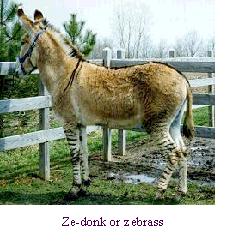Zebra hybrid is an all-encompassing term for a zebra crossed on any other equine. The term Zorse is to used to describe the cross of a zebras stallion to a horse mare. Other terms seen are Zebroid, Zony (zebra x Pony) or Zeony. Zebra -donkey crosses are termed Zebroid, Zebrass, Zonkey or Ze-donk. A more romantic (but not technically accurate) term that has recently surfaced is "Golden Zebra", used for any zebra hybrid. The once popular term "Zebra mule" is no longer used either.
Zebra stallions are used primarily for zebra Hybrid breeding. Zebra mares are needed for the production of purebred zebras. The rare "Zebra hinny" (also called a zebret in older texts, and more recently coined "Zebrinny") has been seen, but zebra stallions that are hand-raised (as opposed to nursed by his zebra mother) with horses or donkeys are much easier to use in Zebroid (Zorse, zedonk, zonkey, zony) production.
Zebras may appear to have "ponyish" bodies, but the hip shape does differ as well. Zebras ears are larger and rounder than horse ears. The Mountain zebras have almost donkey-like ears, while the Grevy's zebra sports a huge flared conical ear. The necks are characteristically straighter in the longears, and most donkeys and all zebras lack a true wither. The manes are stiff and upright, and zebras, like donkeys, have no forelocks. Zebras have variety of noises, most commonly the "qua-ha" or "barking" sound. These traits are all passed along, in part, just as they are in Mules, to zebra Hybrid offspring. Most Zebrasses (Zebra X Donkey crosses) look just like donkeys with zebras striping on the colored coat.
There are several variations of the striping patterns in the zebra, from the broad sweeping flank stripes of the Grants to the shadow stripes of the Damarland, to the numerous narrow body striped and white belly of the Grevys. These three varieties of zebra are the most commonly seen in zebra hybrid breeding. However, it seems that no matter the exact pattern of the zebra sire, many zebroids may actually have more stripes over the hips and back than the parents. Typically a zebra hybrid will have boldly striped legs, a clearly marked dorsal stripe, and varying degrees of striping on the face, neck, shoulders and body. The stripes are dark brown or black against coats of all horse colors, or may even appear red on chestnut or sorrel coats. Pinto mares may throw zebra hybrid foals with pinto coats, where the dark stripes are overlaid on the dark areas. Care should be taken in breeding roans or grays for hybrids, as these colors could obscure the stiping patterns as the white hairs progress.
Zebra hybrids, depending on the parents, will be either more horselike or more ass-like in body shape. They also are typically smaller than most horses or mules. Most zebra breeds are small, even the largest variety, the Grevys, is only about 13 hands high. Zebroids can be bred larger by using tall, well-bred mares of all saddle types. Stock mares are very popular for producing saddle and harness zebroids.
Zebra hybrids are growing in popularity. Although the zebra is a true wild animal, if carefully raised around domestic equines from a very young age, even pure zebras can be used under saddle, as pack animals, or in harness. Few breeders will use zebras this way, instead concentrating on the colorful zebroid offspring.
Zebras lack withers, and saddles are difficult to fit to the animals. The hybrids are shaped more like the non-zebra parent, and also usually have better personalities. This makes them the more ideal candidates for working animals. As more breeders are crossing zebra stallions to a variety of good mares, it is hoped that someday there will be classes of striped Zebra hybrids in the showring to compliment the spotted and patched mule and donkey Color classes.
Zebra hybrids are not for everyone, though. People who have never owned and trained an equine should be discouraged from owning a zebra hybrid for their first equine. The responses of the hybrid differ from that of horses, and they are very quick. Novices should gain some experience working with horses or mules, and then later obtain an adult, well-trained hybrid. ADMS has a list of breeders and sellers of Zorses available from the office.

RULES PHOTOS Types
Right for me? Try a MODEL
BREEDERS LINKS
No, there is no such thing as a miniature Zebra. There are miniature horses, miniature mules, miniature donkeys, miniature cattle, even miniature llamas, but there are no mini-zebras. To start, zebras are only about 11-12 hands (Plains variety) to begin with. That's 44-48". Miniatures in most other "large breeds" are average under 39". Over thousands of years of natural selection in zebras, you see they have stayed the same height. No giants, no minis. Any of these would quickly be culled by predators in the wild. To get a miniature version of an animal, you must selectively breed domesticated stock. Zebras are still wild animals, there are no strains of truly domesticated zebra. One would have to select for size above all other characteristics to produce an even small zebra. Much more emphasis should be placed on breeding zebras (especially those for the "exotic" market) for temperament and conformation. Those with volitile tempers and poor bite (anything over 1/4" and certainly discard anything with more than 1/2" over or under-bite) should NOT be used as breeding stock, whether for zebra or hybrid productions.
Plains Quagga Mountain Grevy's